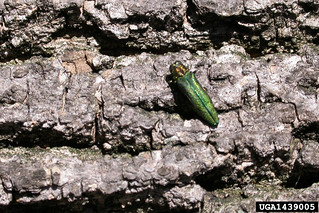Firewood provides great mass transportation for invasive pests
Emerald Ash Borer. (Image courtesy Taylor Scarr, Ontario Ministry of Natural Resources, Bugwood.org) CREDIT MANDATORY
Fast facts
- April is Invasive Plant Pest and Disease Awareness Month
- Visit http://www.arinvasives.org/ to learn to ID threats
- Visit www.dontmovefirewood.org/ to learn how to put the brakes on the emerald ash borer
(450 words)
LITTLE ROCK -- That firewood you’re planning to take on your next camping trip could turn out to be luxury mass transit for the next big invasive insect and tree disease, said Tamara Walkingstick, associate director of the Arkansas Forest Resource Center.
“So many of the invasive pests we already have in the United States came accidentally -- hitchhiking in wood pallets or other wood shipments,” she said. “The Formosan termite is such an example.”
The U.S. Department of Agriculture estimates the Formosan termite causes $1 billion in damage every year.
Another pest that uses wood to hitchhike is the emerald ash borer. This tiny, green metallic insect was first found in North America in 2002 and may have been here since the 1990s.
Hitchhiking insects are also implicated in the spread of Thousand Cankers Disease that threatens the black walnuts of the eastern half of the U.S.
“In the case of the emerald ash borer, adults feed on ash tree leaves, but the fatal damage to trees is caused by larva that feed on the inner bark of the ash trees,” she said. “They destroy 100 percent of the ash trees in infested areas.”
Ash trees make up a good percentage of river bottom forests in eastern Arkansas, and the insect appears poised on the state’s northern border with Missouri.
“The emerald ash borer moves mostly by hitchhiking on raw wood products such as firewood and logs,” she said. “The best means to control it is to not move firewood.”
Even if your firewood doesn’t have holes, burrows sawdust or other abnormalities, don’t move it.
“The insect eggs are the size of a pin and invasive fungi spores are microscopic, so it’s not save to assume that any firewood is OK to move,” Walkingstick. “It only takes one log to destroy a whole ecosystem.”
Even if the plan is to burn all of the wood, “It’s still possible that a fallen flake of bark or an egg or spore could drop off in the woods or on your vehicle before the first match is struck, the hitchhiker still has a chance to set up home in a new location,” she said.
While many are familiar with quarantines imposed due to red imported fire ant infestation, many might be surprised to learn that there are firewood restrictions. A map of states with firewood movement restrictions may be found here: www.dontmovefirewood.org/the-problem/state-state-information/index.html.
“If you see a suspected invasive, report it to your county extension office or the state plant board,” Walkingstick said.
To learn more about the campaign to keep log-based forestry pests from spreading, see www.dontmovefirewood.org/.
A fact sheet from the Cooperative Extension Service is available:
“Emerald Ash Borer: A potential pest of ash trees in Arkansas”, downloadable at www.uaex.uada.edu/publications/pdf/FSA-7066.pdf
For more information about invasive species in Arkansas, visit http://www.arinvasives.org/, our newly revamped site at www.uaex.uada.edu, or contact your county extension office.
Pursuant to 7 CFR § 15.3, the University of Arkansas System Division of Agriculture offers all its Extension and Research programs and services (including employment) without regard to race, color, sex, national origin, religion, age, disability, marital or veteran status, genetic information, sexual preference, pregnancy or any other legally protected status, and is an equal opportunity institution.
By Mary Hightower
U of A System Division of Agriculture
Media Contact: Mary Hightower
Dir. of Communication Services
U of A Division of Agriculture
Cooperative Extension Service
(501) 671-2126
mhightower@uada.edu
Related Links
